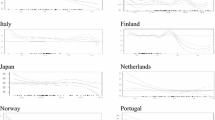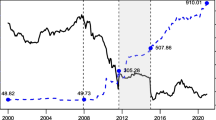Abstract
This paper tests an efficient market hypothesis for the Russian ruble–UK sterling exchange rates in the gold standard period 1897–1913. Using Bayesian Markov Chain Monte Carlo methods it is shown how to test a weak-form market efficiency in a doubly truncated regression model with ARMA-GARCH error. The suggested model accounts for time series characteristics of the data and bounds of exchange rates caused by the gold points and government intervention. We find that the weak-form efficiency hypothesis can not be rejected for the gold standard ruble exchange rates in both St.Petersburg and London markets.








Similar content being viewed by others
Notes
In 1895 the intervention was repeated on a smaller scale and after that no unusual speculative activities in the German forward market were observed.
Russia was the 4th largest gold producer in the world following the U.S., Australia and South Africa.
Bokhanov (1994) says that in the last years of the 19th century annual industrial growth for the leading industries was 12–15%.
The drift term may be given by the difference between interest rates in two countries.
y t are not censored, there is no mass of points on the bounds. This is a truncated rather than a censored model.
After 1904 the data was missing in the publications of EMF, as a result the collected monthly data for St. Petersburg exchange rate on London consists of n=96 observations.
Flandreau (1996) data were originally collected from the Economist.
We note that 3 month bills of exchange are slightly different from 3 month forward exchange rates, since the time of payment for the bill of exchange is today, while in the forward exchange rate contact payment is at the specified future date. Thus, the forward exchange rate has an additional element of risk.
The available data for b t are monthly averages, while the b t * observations are at the beginning of each month.
The rate is usually called a sight rate rather than a spot rate since additional legal grace period of 3 days for bills of exchange was allowed. However, additional interest cost is negligible.
The choice of the end of each month is because it is closest to the observations of exchange rate in London market that are at the beginning of each month. Data were originally collected from The Economist. After 1900 The Economist stopped quoting a market interest rate for Russia and starting from 1901 we use St. Petersburg bank rate instead.
We thank anonymous referee for pointing out that the 3-month trade bill rate was used by merchants and bankers to conduct trade and is a better instrument to impute the sight rate for St.Petersburg. Unfortunately, these data are not publicly available. We also noted that for considerable period Russian market interest rate was not available and we used St.Petersburg bank rate instead. If data were available we could use market rate in both cases for the whole period.
We also show the exchange rate parity between the Russian ruble and UK sterling that was equivalent to 1 ruble=0.105 sterling. The St.Petersburg market exchange rate was slightly above the parity for the period 1897–1904 while at the same time it was fluctuating around the parity in London market. One of the reasons for this could be the use of bank rather than market interest rate for adjustment of sight rate, as was pointed out by an anonymous referee.
Thirteen percent increase was to finance the war with Japan and the rest was issued in the period of revolution (Petrov (1994)).
By the Russian law metallic coverage had to be at least 50% for the amount of bills of credit issued up to 600 million rubles and 100% coverage for each paper ruble issued after that amount.
After 1905 the new finance minister Kokovtsev followed the policy of fiscal austerity. He managed to reduce the amount of credit rubles that were issued during 1905 and accumulate gold reserves, so that the cover ratio was restored. First, reserves were accumulated by foreign borrowing mostly from France, but later after 1909 government stopped making foreign loans. Its revenues came from successful exploitation of state railroads, the wine monopoly, taxes and domestic borrowing. Kokovstev refrained from additional foreign borrowing since the burden of interest payments from previous loans by 1913 already accounted for 13.7% of the budget.
If we knew the exact dates of such interventions, which we do not, we could account for this effect in our estimation.
A substantial portion of the gold reserves was kept abroad in order to pay the debt and intervene in the foreign markets of Russian securities. This was also done to ensure foreign investors of the credibility of the Russian ruble (see Stepanov (1994)).
Except for 1905–1906 war and revolution years.
Intervention bounds are possibly narrower than the gold points.
The reserves and government deficit dynamics figures are given in Table 5.
We used Laplace-Metropolis estimation of marginal likelihood, alternatively one could use Chib and Jeliazkov (2001) estimator.
The constant term parameter is not identifiable in the presence of a unit root, so we do not need to test whether γ 0≠0.
Algorithm for the threshold parameters was developed in Goldman (2004).
The rule of thumb is 15% of total number of observations.
References
Bokarev YP, Bohanov AN, Katihova LA, Petrov YA, Stepanov VL (1994) Russian ruble. Two centuries of history. XIX–XX centuries. Progress-Akademia, Moscow
Bokhanov AN (1994) Golden ruble. In: Bokarev YP, Bohanov AN, Katihova LA, Petrov YA, Stepanov VL (eds) Russian ruble. Two centuries of history. XIX–XX centuries. Progress-Akademia, Moscow
Bordo MD, Rockoff H (1996) “The gold standard as a” good housekeeping seal of approval. J Econ Hist 56:389–428
Campbell JY, Lo AW, MacKinlay AC (1997) The econometrics of financial markets. Princeton University Press, New Jersey
Canjels E, Prakash G, Taylor AM (2004) Measuring market integration: foreign exchange arbitrage and the gold standard, 1879–1913. Rev Econ Stat 86:868–882
Capie F, Webber A (1985). A monetary history of the United Kondom, 1870–1982: Vol I, Data, Sources, Methods. George Allen and Unwin, London
Chib S, Greenberg E (1994) Bayes inference in regression models with ARMA(p,q) errors. J Econom 64:183–206
Chib S, Greenberg E (1995) Understanding the Metropolis–Hastings algorithm. Am Stat 49:327–335
Chib S, Jeliazkov I (2001) Marginal likelihood from the Metropolis–Hastings output. J Am Stat Assoc 96:270–281
Clark TA (1984) Violations of the gold points 1890–1908. J Polit Econ 92:791–823
Crisp O (1976) Studies in the Russian economy before 1914. Barnes and Noble books, New York
Einzig P (1970) The History of Foreign Exchange, Macmillan and Co LTD, London. Ezhegodnik Ministerstva Finansov (1898–1905) Cpb
Fama E (1970) Efficient capital markets: a review of theory and empirical work. J Finance 25:383–417
Flandreau M (1996) The French crime of 1873: an essay on the emergence of the international gold standard, 1870–1880. J Econ Hist 56:862–897
Flandreau M, Komlos J (2001) How to run a target zone? Age old lessons from an Austro-Hungarian experiment 1896–1913, manuscript
Gatrell P (1994) Government, industry, and rearmament in Russia, 1900–1914: the last argument of tsarism. Cambridge University Press
Goldman E (2000) Testing efficient market hypothesis for the dollar–sterling gold standard exchange rate 1890–1906: MLE with double truncation. Econ Lett 69:253–259
Goldman E (2004) Bayesian analysis of a multiple threshold ARMA model with CKLS-GARCH volatility. working paper, Pace University
Goldman E, Tsurumi H (2005) Bayesian Analysis of a Doubly Truncated ARMA-GARCH Model. Studies in Nonlinear Dynamics and Econometrics, 9 (2), article 5
Gregory P (1982) Russian national income. Cambridge University Press
Juhl T, Miles W, Weidenmier M (2006) Covered Interest arbitrage: then vs. now. Economica, forthcoming
Kashkarov M (1898) Denezhnoye Obrashenie v Rossii, vol 1–2. St.Petersburg
Khromov PA (1950) Economic development of Russia in the 19th and 20th centuries, 1800–1917 (Moscow)
Kaufman II (1892) Vekselniye kursi Rossii za 50 let 1841–1890. St.Petersburg
Morgenstern O (1959) International financial transactions and business cycles. Princeton University Press for NBER, Princeton, NJ
Nakatsuma T (2000) Bayesian analysis of ARMA-GARCH models: a Markov chain sampling approach. J Econom 95:57–69
Obstfeld M, Taylor AM (2003) Sovereign risk, credibility and the gold standard: 1870–1913 versus 1925–31. Econ J 113:241–275
Officer L (1986) The efficiency of the dollar–sterling gold standard, 1890–1908. J Polit Econ 94(5):1038–1073
Officer L (1989) The remarkable efficiency of the dollar–sterling gold standard. J Econ Hist 49(1):1–41
Officer L (1996) Between the dollar–sterling gold points. Cambridge University Press
Peel D, Taylor M (2002) Covered interest rate arbitrage in the interwar period and the Keynes–Einzig conjecture. J Money, Credit Bank 34:51–75
Perkins BJ (1978) Foreign interest rates in American financial markets: a revised series of dollar–sterling exchange rates, 1835–1900. J Econ Hist 38:392–419
Petrov YA (1994) The Kokovtsev system. In: Bokarev YP, Bohanov AN, Katihova LA, Petrov YA, Stepanov VL (eds) Russian ruble. Two centuries of history. XIX–XX centuries. Progress-Akademia, Moscow
Prakash G, Taylor AM (1997) Measuring market integration: a model of arbitrage with an econometric application to the gold standard, 1879–1913. In: NBER Working Paper, Vol. No. 6073
Stepanov VL (1994) From the End of the Kankarin System to a New Reform. In: Bokarev YP, Bohanov AN, Katihova LA, Petrov YA, Stepanov VL (eds) Russian ruble. Two centuries of history. XIX–XX centuries. Progress-Akademia, Moscow
Tainov IG (1910) Gold circulation and Central Banks of major countries. Saint Petersburg 141–143
Tsurumi H (1998) Econometrics II. Lecture notes, Department of Economics, Rutgers University
Tsurumi H, Chen J (1998) Testing the purchasing power theory: a case of the Taiwanese dollar exchange rate. J Econom Integr 13:232–254
Weidenmier M, Neal L (2001) The global economy in crisis: contagion and circumstance from Tulips to today. NBER working paper
Acknowledgments
I am grateful to Professors Hiroki Tsurumi, Michael Szenberg, Michael Bordo, and Eugene White for their insight and guidance. I thank Professors Marc Flandreau and Marc Weidenmier for sharing their data with me.
Author information
Authors and Affiliations
Corresponding author
Appendix
Appendix
Rights and permissions
About this article
Cite this article
Goldman, E. Testing efficiency of the ruble-sterling foreign-exchange market under the gold standard. Empirical Economics 31, 449–477 (2006). https://doi.org/10.1007/s00181-005-0025-6
Received:
Accepted:
Published:
Issue Date:
DOI: https://doi.org/10.1007/s00181-005-0025-6




